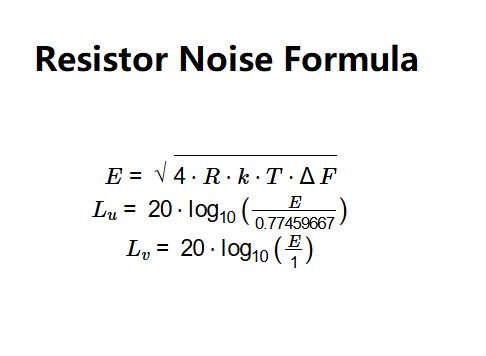1. What is a Resistor Noise Calculator?
Definition: This calculator computes the thermal noise voltage (E), noise level (Lu), and noise level (Lv) generated by a resistor due to the thermal agitation of electrons.
Purpose: It is used in electronics to evaluate the noise performance of resistors in circuits, crucial for low-noise amplifier design and signal integrity.
2. How Does the Calculator Work?
The calculator uses the following equations:
\( E = \sqrt{4 \cdot R \cdot k \cdot T \cdot \Delta F} \)
\( L_u = 20 \cdot \log_{10} \left( \frac{E}{0.77459667} \right) \)
\( L_v = 20 \cdot \log_{10} \left( \frac{E}{1} \right) \)
Where:
- \( E \) is the RMS noise voltage (V)
- \( R \) is the resistance (Ω)
- \( k \) is Boltzmann’s constant (\( 1.380649 \times 10^{-23} \, \text{J/K} \))
- \( T \) is the temperature (K)
- \( \Delta F \) is the bandwidth (Hz)
- \( L_u \) and \( L_v \) are noise levels in dB with reference voltages 0.77459667 V and 1 V, respectively
Steps:
- Enter resistance (R), temperature (T), and bandwidth (ΔF)
- Convert inputs to base units (Ω, K, Hz)
- Calculate \( E \), \( L_u \), and \( L_v \) using the formulas
- Display \( E \) in nV, µV, mV, or V based on magnitude
3. Importance of Resistor Noise Calculation
Thermal noise sets the baseline noise floor in electronic circuits, affecting the signal-to-noise ratio and limiting the sensitivity of amplifiers and receivers.
4. Using the Calculator
Examples:
- For \( R = 20 \, \text{kΩ} \), \( T = 20 \, \text{°C} \), \( \Delta F = 1 \, \text{kHz} \):
- \( E = 569.15515 \, \text{nV} \)
- \( L_u = -62.33658 \, \text{dB} \)
- \( L_v = -64.89631 \, \text{dB} \)
- For \( R = 1 \, \text{MΩ} \), \( T = 25 \, \text{°C} \), \( \Delta F = 1 \, \text{MHz} \):
- \( E = 128.30078 \, \text{µV} \)
- \( L_u = -15.61304 \, \text{dB} \)
- \( L_v = -17.83849 \, \text{dB} \)
5. Frequently Asked Questions (FAQ)
Q: What is thermal noise?
A: Thermal noise, or Johnson-Nyquist noise, is the random voltage generated by electron movement in a resistor due to temperature, independent of applied voltage.
Q: Why are Lu and Lv different?
A: They use different reference voltages (0.77459667 V for Lu, 1 V for Lv), reflecting different standards for noise measurement.
Resistor Noise Calculator© - All Rights Reserved 2025
 Home
Home
 Back
Back
